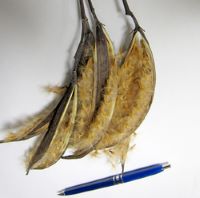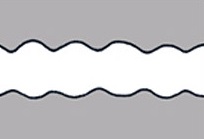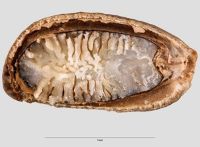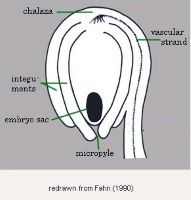Content is from Kirkbride et al. 2006Kirkbride et al. 2006:
Kirkbride JH, Jr, Gunn CR, and Dallwitz MJ. 2006. Family guide for fruits and seeds, vers. 1.0. Accessed September 2020-January 2022. URL: https://nt.ars-grin.gov/seedsfruits/keys/frsdfam/index.cfm ., without modification.
Updates are forthcoming.
Fruits: Fruit pericarpium, or anthocarpanthocarp:
simple or compound and including some tissue of non-ovarian origin (accessory tissue) ; simple, or multiplemultiple:
; simple, or multiplemultiple:
fruit formed from several flowers clustered in one mass
; Anaxagorea folliclefollicle:
a dry to (rarely) fleshy fruit derived from a single carpel that opens along a single longitudinal suture, derived from a single, superior, simple ovary; the seeds may be arillate or with a fleshy testa , or berryberry:
, or berryberry:
an indehiscent, fleshy fruit with one or a few to many seeds. The flesh may be homogenous throughout. Or, if the outer part is hard, firm, or leathery, referred to as an hesperidium. Septa are present in some, and the seeds may be arillate or with a fleshy testa. (neither Spjut); camaretum (Spjut, Fig. 14F), or baccetum (Asimina triloba), or follicetum (Anaxagorea), or lomentetum, or syncarpium (Monanthot axisaxis:
(neither Spjut); camaretum (Spjut, Fig. 14F), or baccetum (Asimina triloba), or follicetum (Anaxagorea), or lomentetum, or syncarpium (Monanthot axisaxis:
a straight line through the center of a structure around which the parts are usually symmetrically arranged, as in the stem or rachis of an inflorescence
& only family: Spjut, Fig. 38D); berryberry:
an indehiscent, fleshy fruit with one or a few to many seeds. The flesh may be homogenous throughout. Or, if the outer part is hard, firm, or leathery, referred to as an hesperidium. Septa are present in some, and the seeds may be arillate or with a fleshy testa. indehiscent; berryberry:
indehiscent; berryberry:
an indehiscent, fleshy fruit with one or a few to many seeds. The flesh may be homogenous throughout. Or, if the outer part is hard, firm, or leathery, referred to as an hesperidium. Septa are present in some, and the seeds may be arillate or with a fleshy testa. without central placental mass; without persistent central column; not within accessory organ(s); from 5.1–10 cm long to more than 10 cm long; 6–11 cm long (at least); with (1–)100-carpellate (=many); with carpels united, or separate; with carpels remaining united at maturity; with carpels remaining connected at stylestyle:
without central placental mass; without persistent central column; not within accessory organ(s); from 5.1–10 cm long to more than 10 cm long; 6–11 cm long (at least); with (1–)100-carpellate (=many); with carpels united, or separate; with carpels remaining united at maturity; with carpels remaining connected at stylestyle:
in a flower, the narrow and elongated part of the pistil between the stigma and the ovary; sometimes persisting in fruit ; without sterilesterile:
; without sterilesterile:
lacking male and/or female reproductive parts; also, not producing fruit or seed
 carpels; apexapex:
carpels; apexapex:
the point farthest from the point of attachment, or the "tip" of an organ not beaked; dehiscentdehiscent:
not beaked; dehiscentdehiscent:
(v. dehisce) splitting open at maturity to release contents (of a fruit) , or indehiscentindehiscent:
, or indehiscentindehiscent:
not opening on its own, as in a fruit
 . Dehiscentdehiscent:
. Dehiscentdehiscent:
(v. dehisce) splitting open at maturity to release contents (of a fruit) unit seed(s). Dehiscentdehiscent:
unit seed(s). Dehiscentdehiscent:
(v. dehisce) splitting open at maturity to release contents (of a fruit) regularly, or irregularly; and shedding seeds; without replumreplum:
regularly, or irregularly; and shedding seeds; without replumreplum:
the rim, formed by the persistent placentas, and connected by a false septum in Brassicaceae fruits. The fruit valves are attached to this rim and separate from it in dehiscent fruits.
. Epicarpepicarp:
outer layer of fruit wall or pericarp, if divided into layers; note here used synonymously with exocarp brown (all shades), or blue (ish), or green; durable; without armature, or with armature; with spines; without wing(s); without apicalapical:
brown (all shades), or blue (ish), or green; durable; without armature, or with armature; with spines; without wing(s); without apicalapical:
at or pertaining to the end of the seed or fruit distal from its point of attachment (i.e., base)
respiratory hole. Mesocarpmesocarp:
the middle layer of the pericarp, if divided into layers present; fleshy; composed of 1 unified layer; without lactiform cavity system. Endocarpendocarp:
present; fleshy; composed of 1 unified layer; without lactiform cavity system. Endocarpendocarp:
the inner layer of the pericarp, if divided into layers present, or absent; not separating from exocarpexocarp:
present, or absent; not separating from exocarpexocarp:
outer layer of fruit wall or pericarp, if divided into layers; note here used synonymously with epicarp ; thin; without operculumoperculum:
; thin; without operculumoperculum:
a dehiscent cap (or lid) of a seed or fruit that opens during germination or dehiscence ; without secretory cavities; without longitudinallongitudinal:
; without secretory cavities; without longitudinallongitudinal:
of or relating to length or the lengthwise dimension
ridges. Funiculusfuniculus:
(alt. funicle) stalk connecting the ovule (later seed) to the ovary (later fruit) placenta short; short without seed bearing hookswith hooks:
short; short without seed bearing hookswith hooks:
bristles or spines with curved or backwards pointing tips, or with secondary bristles along their length (retinacula); not persisting in fruit after seed shed.
(retinacula); not persisting in fruit after seed shed.
Seeds: Arilaril:
(broad sense) appendicular structure that wholly or partly envelops a seed and is produced from or a modification of the funicle, raphe, or outer integument; usually fleshy or pulpy, sometimes spongy or tufted-capillate, often brightly colored absent, or present (Goldberg: "often arillate" but this observation is not confirmed by any other author, and Corner noted "mostly exarillate" but noted Xylopia was an example of an arillate genus); a true arilaril:
absent, or present (Goldberg: "often arillate" but this observation is not confirmed by any other author, and Corner noted "mostly exarillate" but noted Xylopia was an example of an arillate genus); a true arilaril:
(broad sense) appendicular structure that wholly or partly envelops a seed and is produced from or a modification of the funicle, raphe, or outer integument; usually fleshy or pulpy, sometimes spongy or tufted-capillate, often brightly colored ; red, or yellow, or blue, or gray; well developed, or vestigal (Annona, Canangium & these are from indehiscentindehiscent:
; red, or yellow, or blue, or gray; well developed, or vestigal (Annona, Canangium & these are from indehiscentindehiscent:
not opening on its own, as in a fruit
 fruits); adnate to hilumhilum:
fruits); adnate to hilumhilum:
on seeds, the scar indicating where the funiculus was attached; on grass caryopses, the scar visible on the outer fruit surface revealing where the seed is attached on the inner fruit wall surface; or in Asteraceae cypselae, the scar visible on the outer fruit wall revealing where the fruit was attached to the receptacle ; fleshy; of funicularfuniculus:
; fleshy; of funicularfuniculus:
(alt. funicle) stalk connecting the ovule (later seed) to the ovary (later fruit) placenta origin; encompassing, or basalbasal:
origin; encompassing, or basalbasal:
at or pertaining to the point of attachment; (of embryo) embryo occupies one end of the seed
; does not aid in seed explusion from fruit; fleshy. Seed larger than minute; 5 to less than 10 mm long to 25 to less than 50 mm long (5–30); ellipsoidellipsoid:
3D shape—elliptic
, or oblongoblong:
2D shape—much longer than broad with nearly parallel sides, corners are rounded , or ovateovate:
, or ovateovate:
2D shape—egg-shaped in outline, widest point is towards one end of the organ, the other end tapers gradually, attachment at or near the broad end (compare obovate, ovoid) ; in transection compressedcompressed:
; in transection compressedcompressed:
flattened; in grasses, used to denote compression (not necessarily flattened) either laterally or dorsiventrally
; not bowl shaped; not nutlike; without winglike beakbeak:
a usually firm, terminal appendage, sometimes tapered ; without caudatecaudate:
; without caudatecaudate:
tapering to a long, tail-like appendage appendage(s); at maturity with food reserves; with endosperm; without canavanine. Sarcotestasarcotesta:
appendage(s); at maturity with food reserves; with endosperm; without canavanine. Sarcotestasarcotesta:
pulpy or fleshy outer layer of the seed coat, simulates aril absent, or present (thin); fleshy. Testatesta:
absent, or present (thin); fleshy. Testatesta:
seed coat
 present, or absent (when scarotesta present); without embryo surrounded and capped by viscid tissue; with fleshy or leatheryleathery:
present, or absent (when scarotesta present); without embryo surrounded and capped by viscid tissue; with fleshy or leatheryleathery:
texture—moderately thick, tough, and very pliable
layer over hard layer; surface smooth, or unsmooth; surface with merged raised features; surface undulateundulate:
wavy-margined
 , or wrinkledwrinkled:
, or wrinkledwrinkled:
surface relief—shallow, irregular folds and furrows covering the surface; appearing overall though crumpled and then spread out ; without crease or line separating cotyledons from hypocotyl-radicle, or with crease or line separating cotyledons from hypocotyl-radicle; without notch along margin where cotyledons from hypocotyl-radicle tip approach each other, or with notch along margin where cotyledons from hypocotyl-radicle tip approaching each other; without glands; without bristles; glabrousglabrous:
; without crease or line separating cotyledons from hypocotyl-radicle, or with crease or line separating cotyledons from hypocotyl-radicle; without notch along margin where cotyledons from hypocotyl-radicle tip approach each other, or with notch along margin where cotyledons from hypocotyl-radicle tip approaching each other; without glands; without bristles; glabrousglabrous:
without hairs
, or pubescentpubescent:
surface relief—bearing hairs
; with hairs over surface; with short hairs (minute: Gonioyhalamus); without glandularglandular:
surface relief—covered with small, raised secretory glands, regular or irregularly shaped, translucent or opaque, and maybe distinctly colored pubescence; with wing(s) (Richella); 1-winged; without collar; without operculumoperculum:
pubescence; with wing(s) (Richella); 1-winged; without collar; without operculumoperculum:
a dehiscent cap (or lid) of a seed or fruit that opens during germination or dehiscence ; colored; monochrome; brown (all shades), or black; not becoming mucilaginousmucilaginous:
; colored; monochrome; brown (all shades), or black; not becoming mucilaginousmucilaginous:
resembling mucilage; moist and sticky
when wetted, or becoming mucilaginousmucilaginous:
resembling mucilage; moist and sticky
when wetted; surrounding food reserve. Hilumhilum:
on seeds, the scar indicating where the funiculus was attached; on grass caryopses, the scar visible on the outer fruit surface revealing where the seed is attached on the inner fruit wall surface; or in Asteraceae cypselae, the scar visible on the outer fruit wall revealing where the fruit was attached to the receptacle small. Endosperm copious; hard, or fleshy; ruminateruminate:
small. Endosperm copious; hard, or fleshy; ruminateruminate:
testa or seed coat folded into the endosperm ; without starch, or with starch; with starch composed of solitary grains (firm); with oils; without fatty acid containing cyclopropene; without apicalapical:
; without starch, or with starch; with starch composed of solitary grains (firm); with oils; without fatty acid containing cyclopropene; without apicalapical:
at or pertaining to the end of the seed or fruit distal from its point of attachment (i.e., base)
lobes; without chlorophyll; without isodiametric faceted surface; without odor. Embryo differentiated from food reserve; well developed; 1 per seed; partially filling testatesta:
seed coat
 (with food reserve); 0.1–0.3 times the length of food reserve; at one end of seed not extending into a depression or cup; axileaxile:
(with food reserve); 0.1–0.3 times the length of food reserve; at one end of seed not extending into a depression or cup; axileaxile:
on or of the axis
and centric, or basalbasal:
at or pertaining to the point of attachment; (of embryo) embryo occupies one end of the seed
; linearlinear:
(shape) long, narrow, and uniform in width; (of embryo) embryo is straight and much longer than wide ; straight; without coleorhiza; without simmondsin; without stomata; not green; with 2 or more cotyledons. Cotyledons 2; undifferentiated to 0.1–0.3; as wide as hypocotyl-radicle; smooth; equal in size; not punctatepunctate:
; straight; without coleorhiza; without simmondsin; without stomata; not green; with 2 or more cotyledons. Cotyledons 2; undifferentiated to 0.1–0.3; as wide as hypocotyl-radicle; smooth; equal in size; not punctatepunctate:
surface relief—dotted with pits or with translucent, sunken glands or with colored dots, similar to pitted dotted. Hypocotyl-radicle well developed; straight; not thickened.
dotted. Hypocotyl-radicle well developed; straight; not thickened.
 coalesce with receptacle. Anaxagorea dehisces explosively. Spjut's fruit list is not complete. Based on following we also have scored berryberry:
coalesce with receptacle. Anaxagorea dehisces explosively. Spjut's fruit list is not complete. Based on following we also have scored berryberry: and folliclefollicle:
and folliclefollicle: . Cronquist: "Fruit commonly separate, stipitatestipitate:
. Cronquist: "Fruit commonly separate, stipitatestipitate: , berry-like carpels, varying to sometimes dry and dehiscentdehiscent:
, berry-like carpels, varying to sometimes dry and dehiscentdehiscent: (Anaxogorea) or indehiscentindehiscent:
(Anaxogorea) or indehiscentindehiscent: , or the carpels sometimes coalescent to form an aggregtate fruit…" and "gynoceum of (1) to more or less numerous conduplicate carpels on flat or conic receptacles, the carpels distinct or rarely (Monodora & Isolona) connate to form a compound ovary".
, or the carpels sometimes coalescent to form an aggregtate fruit…" and "gynoceum of (1) to more or less numerous conduplicate carpels on flat or conic receptacles, the carpels distinct or rarely (Monodora & Isolona) connate to form a compound ovary".
Literature specific to this family: Setten, A.K. van, et al. 1992. Fruits and seeds of Annonaceae. Biblioth. Bot. 142:1–101 with 50 plates; Verdourt, B. 1971. Annonaceae. In: E. Milne-Redhead & R.M. Polhill, eds., Flora of Tropical East Africa. Crown Agents for Oversea Government & Administrations, London; Corner, E.J.H. 1949.The annonaceous seed and its four integumentsintegument:
ring-like or hood-like structure(s) that envelopes the nucellus, at maturity is the layers of the seed coat . New Phytol. 48: 332–364.
. New Phytol. 48: 332–364.
General references: Baillon, H.E. 1866–95. Histoire des plantes, 13 vols. Hachette & Co., Paris, Corner, E.J.H. 1976. The seeds of Dicots, esp. vol. 2. Cambridge University Press, New York, Cronquist, A. 1981. An integrated system of classification of flowering plants, 1,262 p. Columbia University Press, New York, Gaertner, J. 1788–1805. De fructibus et seminibus plantarum. The Author, Stuttgart, Goldberg, A. 1986 (dicots) & 1989 (monocots). Classification, evolution, and phylogeny of the familes of Dicotyledons. Smithsonian Contr. Bot. 58 for dicots (314 pp.) & 71 for monocots (74 pp.). [Goldberg's illustrations are reproduced from older publications and these should be consulted], Gunn, C.R. & J.V. Dennis. 1976. World guide to tropical drift seeds and fruits, 240 pp. The New York Times Book Co., New York, Gunn, C.R. & C.A. Ritchie. 1988. Identification of disseminulesdisseminule:
detachable plant part capable of being disseminated and of propagating, commonly a seed or fruit
listed in the Federal Noxious Weed Act. Techn. Bull. U.S.D.A. 1719:1–313, Gunn, C.R., J.H. Wiersema, C.A. Ritchie, & J.H. Kirkbride, Jr. 1992 & amendments. Families and genera of Spermatophytes recognized by the Agricultural Research Service. Techn. Bull. U.S.D.A. 1796:1–500, Mabberley, D.J. 1987. The plant-book, 706 p. Cambridge University Press, Cambridge, Martin, A.C. 1946. The comparative internal morphology of seeds. Amer. Midl. Naturalist 36:513–660, Roosmalen, M.G.M. van. 1985. Fruits of the Guianan flora, 483 pp. Institute of Systematic Botany, Wageningen Agricultural University. Drukkerij Veenman B.V., Wageningen, Schopmeyer, C.S. 1974. Seeds of Woodywoody:
texture—consisting mainly of indurate lignified tissues, characteristic of or resembling wood
plants in the United States. Agric. Handb. 450:1–883, Spjut, R.W. 1994. A systematic treatment of fruit types. Mem. New York Bot. Gard. 70:1–182, and Wood, C.E., Jr. 1974. A student's atlas of flowering plants: Some dicotyledons of eastern North America, 120 pp. Harper & Row, New York.